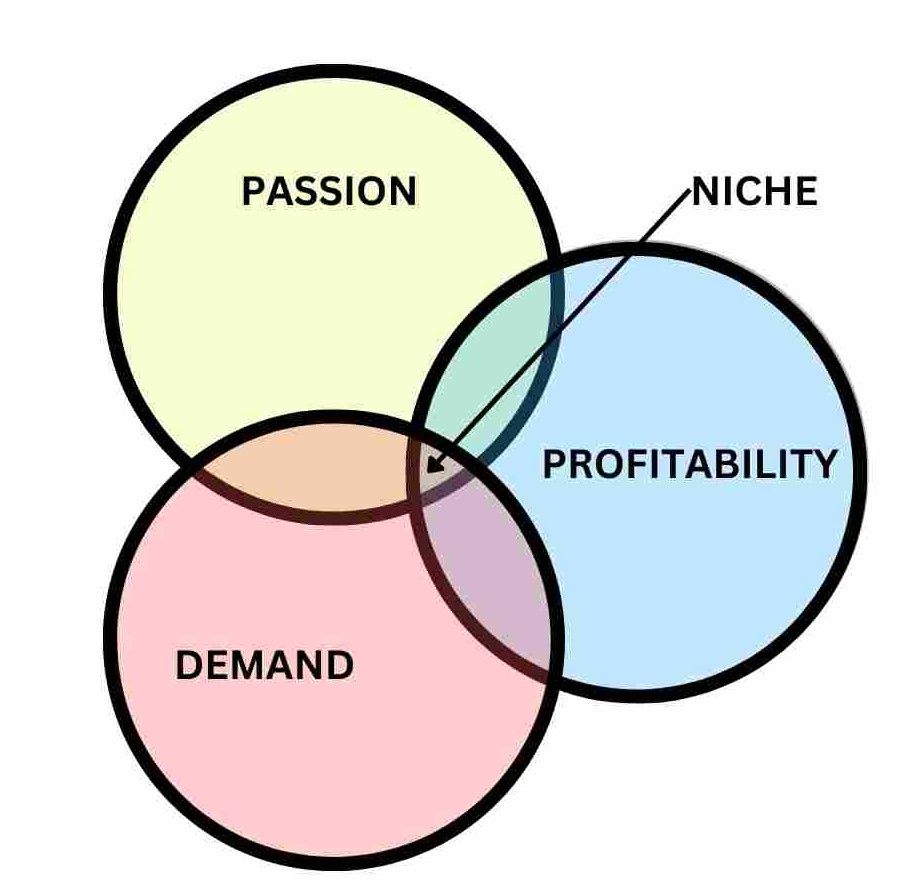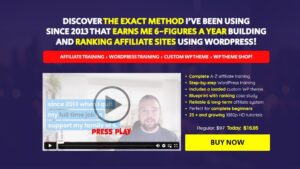Inspired by the idea of Make money online through affiliate marketing while browsing the web or catching up on videos? Well, affiliate marketing might be your golden ticket! It’s a strategy where you can promote products or services and get rewarded when people buy through your unique link.
Now, before you jump in, there are a few things to consider. Stay tuned, because I’m here to walk you through how to make money online through affiliate marketing, step-by-step.
Is Affiliate Marketing a Get-Rich-Quick Scheme?
Let’s be honest, who wouldn’t love instant riches? But Make money online through affiliate marketing takes dedication and effort. Think of it like building a garden. You plant the seeds (your content), nurture them with care (consistent promotion), and eventually, you reap the rewards (commissions!).
So, How Do I Get Started?
Here’s a roadmap to get you on your affiliate marketing journey:
1. Finding Your Affiliate Marketing Niche
Think of your niche as your specialty, your corner of the internet where you’ll become a trusted voice. It’s where your passion meets profitability.
For Example, what are you genuinely enthusiastic about? Fitness, travel, gaming, cooking, there’s a niche for almost anything! When you’re passionate about your niche, creating engaging content becomes a breeze.
While excitement is key, don’t forget about profitability. Research your chosen niche to see if there are companies with affiliate programs and if their products are something people are willing to spend money on.
Here’s a personal example: I love fitness and helping people reach their health goals. So, it made perfect sense for me to focus on that niche in my affiliate marketing journey. Another example: Imagine you’re passionate about underwater basket weaving. While fascinating, the market for affiliate programs might be a little limited.
- Consider sub-niches: Let’s say you’re passionate about health and fitness. This is a broad niche, but you could dig deeper into sub-niches like vegan bodybuilding, yoga for beginners, or healthy meal prep. This allows you to target a more specific audience and potentially find even better affiliate programs.
- Think about your audience: When picking a niche, consider who you want to connect with. Are you passionate about helping busy moms cook healthy meals? Or maybe you want to empower young adults to start their fitness journey? Understanding your target audience helps you tailor your content and choose affiliate programs that resonate with them.
Feeling Stuck? Don’t Worry!
Finding the perfect niche can take some time. Here are some tips to help you brainstorm:
- Look at your hobbies and interests. What do you spend your free time reading about or learning?
- Think about your skills and experience. Are you a expert with graphic design software? Maybe you have a background in finance. Your expertise can be a valuable asset in your chosen niche.
- Explore online communities. Join Facebook groups, online forums, or subreddits related to your interests. See what questions people are asking and what problems they’re facing. This can give you valuable insights into potential niches.
Remember, the key is to find that sweet spot where your passion meets profitability. With a little research and exploration, you’ll be well on your way to finding your golden affiliate marketing niche!

2. Choose Your Platform
Before you start creating content, you need a platform – your online launchpad where you’ll connect with your audience and showcase those amazing affiliate products.
Now, there’s no one-size-fits-all answer here. The best platform depends on your strengths, your comfort level, and the type of content you plan to create. Let’s dive into the three main options:
- Website or blog: This gives you complete control over your content and allows you to establish yourself as an authority in your niche.
- Social media: If you have a strong following on Instagram, YouTube, or TikTok, you can promote affiliate products directly to your audience.
- Email list: Building an email list allows you to connect with your audience on a more personal level and promote affiliate offers directly to them.
2.1 Building Your Own Website or Blog:
- Pros:
- Complete Control: You have complete creative freedom over the design, layout, and content of your website. This allows you to establish yourself as a trusted authority in your niche.
- Long-Term Investment: A well-maintained website can become a valuable asset, generating income for years to come.
- Scalability: As your audience grows, you can easily scale your website to accommodate them.
- Flippability: We I say assets, its real asset, which can be sold at somewhere between 20x to 40x monthly profit. For example, if your blog is earning 1000USD per month its can be sold somewhere between 20,000 to 40,000USD.
- Cons:
- Time Investment: Building and maintaining a website takes time and effort. You’ll need to learn the basics of website creation, content management systems (CMS), and potentially some SEO optimization. These routine tasks can be outsourced too. I highly recommended you visit this to outsource some tasks and get some course from here to start learning.
- Cost: There are costs associated with web hosting and domain names. While there are free options available, they might have limitations or branding restrictions.
Here’s an example: If you’re passionate about photography and want to showcase your skills and promote photography gear, a website would be a great platform. You could create blog posts with equipment reviews, tutorials, and stunning travel photos.
2.2 Leveraging Social Media:

- Pros:
- Instant Audience: If you already have a strong social media following, you can tap into that existing audience to promote your affiliate products. No matter its Facebook, Instagram or TikTok.
- Engagement and Community: Social media platforms are great for fostering interaction with your audience. You can answer questions, address concerns, and build a community around your niche.
- Variety of Formats: You can leverage different social media platforms for different content types. Share informative blog posts on Facebook, create engaging product review videos on YouTube, or showcase eye-catching travel photos on Instagram.
- Cons:
- Limited Control: Social media platforms have their own algorithms and rules that can change. You don’t have the same level of control over your content and audience reach compared to a website.
- Short-Term Focus: Social media content tends to be more ephemeral, with new trends and posts quickly replacing older ones.
Let’s say you’re a fitness enthusiast who loves creating workout videos. You could utilize a platform like YouTube to share your exercise routines, equipment reviews, and healthy meal prep tips. You could then strategically place affiliate links for workout clothes, protein powders, or fitness trackers in your video descriptions.
2.3 Building an Email List:
- Pros:
- Direct Connection: An email list allows you to connect with your audience on a more personal level. You can send targeted emails with valuable content and affiliate offers directly to their inbox.
- Higher Engagement: Studies show that email marketing has a higher conversion rate compared to other marketing channels.
- Long-Term Asset: Your email list is an asset you own and control, unlike social media platforms where algorithms can affect your reach.
- Cons:
- Building an Audience Takes Time: Growing an email list requires consistently providing valuable content and building trust with your audience.
- Email Marketing Skills: There’s a learning curve involved in crafting effective email campaigns and understanding email marketing best practices.
- Cost: Email marketing software came with the price; Free ties are available but very limited options and will include services provider branding.
Imagine you’re a tech guru who loves reviewing the latest gadgets and software. You could create a website with in-depth reviews, but you could also build an email list to send out targeted newsletters with exclusive content and early access to your reviews. In those newsletters, you could strategically place affiliate links for the products you recommend.
2.4 Experiment and Find Your Fit:
The best platform for you depends on your individual circumstances and goals. Don’t be afraid to experiment with different platforms or even use a combination of them. The key is to find where you feel comfortable creating content and where your target audience spends their time online.
What platform are you most interested in exploring for Make money online through affiliate marketing? Share your thoughts and questions in the comments below. Let’s keep this conversation going!
3. Find Affiliate Programs

Alright superstars! We’ve identified niche and chosen launchpad, but now comes the exciting part: finding affiliate programs that perfectly align with your content and target audience.
- Here are the two main ways to find these affiliate program.
- Merchant Websites:
- Affiliate Networks:
3.1 Merchant Websites:
- A Direct Approach: Many companies offer affiliate programs directly on their websites. This is a great starting point, especially for well-known brands in your niche.
- Benefits:
- Targeted Programs: You can find programs that are specifically designed for your niche, ensuring a good fit with your content and audience.
- Clear Information: Company websites usually provide detailed information about their affiliate program, including commission rates, program guidelines, and marketing materials.
- How to Find Them: Look for a dedicated “Affiliates” or “Partners” section on the websites of companies you’re interested in promoting. You can also use Google search command, mentioned below, to find.
"Your Niche" Affiliate
OR
Site: Targeted Website "Affiliate"Example: Let’s say you’re rocking your fitness blog and want to promote protein powders. A quick search might lead you directly to the affiliate program page of a reputable protein powder brand. There, you’ll find all the details you need to join their program and start earning commissions.
3.2 Affiliate Networks:
- A Wealth of Opportunities: Affiliate networks act as a bridge between publishers (like you) and advertisers (companies with affiliate programs). They offer a vast directory of programs across various niches.
- Benefits:
- Variety and Choice: You can browse through a wide range of affiliate programs, increasing your chances of finding the perfect fit for your niche and audience.
- Simplified Management: Many affiliate networks allow you to manage multiple affiliate programs from a single dashboard, making it easier to track your earnings and performance.
- Additional Resources: Some networks offer helpful tools and resources for affiliate marketers, such as marketing materials, tracking links, and performance reports.
- Popular Networks: Some of the most popular affiliate networks include ShareASale, Commission Junction, Awin, FlexOffers, and Pepperjam.
Here’s how it works: Imagine you’re passionate about sustainable living and want to promote eco-friendly cleaning products. By joining an affiliate network, you could explore programs from various eco-conscious cleaning product brands, all in one place.
3.3 Choosing the Right Program:
Don’t just jump on board the first program you see! Here are some factors to consider when making your decision:
- Commission Rates: This is the percentage of the sale you earn when someone purchases through your affiliate link. Look for programs with competitive commission rates in your niche.
- Program Reputation: Do your research to ensure the program is reputable and has a good track record of paying commissions on time. Read reviews from other affiliate marketers to get insights.
- Product Relevance: Make sure the products align with your niche and resonate with your target audience. Promoting products you genuinely believe in builds trust and leads to better conversions.
- Program Requirements: Some programs may have specific requirements for joining, such as minimum traffic levels or website content standards. Review these carefully before applying.
Remember: Finding the perfect affiliate programs takes some research and effort. However, by using a combination of merchant websites and affiliate networks, and considering the factors mentioned above, you’ll be well on your way to unlocking a treasure of earning potential!
4. Create High-Quality Content

Up till now we’ve explored our niche, chose a platform, and find some fantastic affiliate programs. Now comes the real magic, creating high-quality content that not only engages your audience but also converts them into paying customers through your affiliate links.
Remember, in the affiliate marketing world, content is king (or queen!). It’s the foundation upon which you build trust, establish yourself as an authority, and ultimately, turn those clicks into commissions.
Here are some winning content ideas to get your creative juices flowing:
4.1 Informative Blog Posts:
- Educate and Entertain: Don’t just bombard your audience with sales pitches. No body like these sales pitches nor google neither audience. Create informative and engaging blog posts that educate your readers on relevant topics within your niche. Include your affiliate links within the content that complement your content and provide value to your audience.
- Keyword Magic: Conduct keyword research to identify topics your target audience is searching for. This ensures your content is relevant and discoverable in search engines. There are many tools available to conduct Keyword research like SEMrush, Aherfs or ubersuggest.
- Problem-Solution Focus: People turn to the internet to solve problems. Identify common pain points within your niche and create content that offers solutions, showcasing how affiliate products can help. You can use SEMrush or AnswerThePublic tool to get the questions people are asking on the internet.
For example: Let’s say your niche is healthy cooking. You could create a blog post titled “5 Easy Weeknight Meals for Busy Families.” Within the post, you could offer healthy recipe ideas that are quick and convenient to prepare. You could then strategically place affiliate links for healthy cooking ingredients or kitchen gadgets that would benefit your readers.
4.2 Engaging Product Reviews:
- Honesty is Key: People appreciate genuine reviews. Don’t just sing praises for every product, be honest about the pros and cons. This builds trust with your audience and positions you as a reliable source of information.
- In-Depth Analysis: Go beyond surface-level descriptions. Provide a detailed analysis of the product’s features, benefits, and potential drawbacks. Consider including high-quality photos or videos to showcase the product in action.
- Target Audience Needs: Focus on how the product addresses the needs and challenges of your target audience. This makes your review more relatable and increases the chance of people clicking on your affiliate links.
Imagine you’re in the fitness niche and promoting a new yoga mat. You could write a review that discusses the mat’s grip, cushion, and portability. You could mention how it addresses common pain points for yogis, such as slipping or having discomfort during extended poses. By strategically placing your affiliate link within the review, you make it easy for interested readers to purchase the mat directly.
4.3 Compelling Videos:
- The Power of Visuals: Videos are a fantastic way to capture attention and engage your audience. Create tutorials, comparisons, or explainer videos showcasing products you’re affiliated with.
- Variety is Key: Experiment with different video formats like short snippets, in-depth reviews, or entertaining product demonstrations.
- Optimize for Search and Sharing: Include relevant keywords in your video titles and descriptions to improve search engine ranking. Optimize your videos for social media sharing to increase reach and engagement.
Let’s say you’re passionate about travel and promoting travel gear. You could create a YouTube video comparing different hiking backpacks. In the video, you could showcase the features of each backpack, discuss its pros and cons based on your travel experiences, and even demonstrate how to pack it efficiently. You could then place your affiliate link for the backpacks in the video description or pin it to a specific point in the video where you’re discussing them.
Remember, consistency is key! Regularly create high-quality content to keep your audience engaged and coming back for more.
5. Promote Your Content and Affiliate Links
Now it’s time to unleash it upon the world and watch those clicks and conversions soar!
Here are some key strategies to promote your affiliate marketing content and maximize its reach:
5.1 Search Engine Optimization (SEO):
- Organic Powerhouse: SEO helps your content rank higher in search engine results pages (SERPs). This means more people will discover your content organically, driving free traffic to your affiliate links.
- Keyword Magic: Research relevant keywords related to your niche and content. Integrate these keywords naturally throughout your content, including titles, meta descriptions, and headings.
- Backlink Building: Earning backlinks from high-quality websites in your niche boosts your website’s authority and improves search engine ranking.
5.2 Social Media Promotion:
- Engage Your Audience: Share your content on your social media platforms and engage with your followers. Respond to comments, answer questions, and participate in relevant conversations to build a community around your niche.
- Choose the Right Platforms: Identify where your target audience spends their time online. Focus on promoting your content on platforms like Facebook, Instagram, Twitter, YouTube, or TikTok, depending on your niche and content format.
- Eye-Catching Content: Create visually appealing social media posts that grab attention and entice people to click through to your content. Utilize eye-catching images, short videos, or engaging social media post formats like stories or polls.
5.3 Paid Advertising (Optional):
- Targeted Reach: Consider using paid advertising platforms like Google Ads or social media advertising to reach a wider audience beyond your organic reach.
- Laser Targeting: These platforms allow you to target your ads to specific demographics and interests, ensuring you reach people likely to be interested in your content and affiliate products.
- Track and Analyze: Monitor the performance of your paid advertising campaigns and adjust your targeting or budget allocation based on the results.
Paid advertising can be a powerful tool, but it requires a strategic approach. Let’s say you wrote a comprehensive guide on “Building a Sustainable Home.” You could run targeted Facebook Ads promoting your guide to people interested in eco-friendly living, significantly increasing the chances of reaching potential customers for the sustainable home products you recommend in your guide.
5.4 Collaboration is Key:
- Partner Power: Connect with other bloggers, YouTubers, or influencers in your niche. Explore guest blogging opportunities, collaborations on video content, or even co-hosting webinars. This can expose you to a new audience and potentially lead to more affiliate clicks.
- Community Building: Engage with online communities related to your niche. Participate in forums, Facebook groups, or Reddit threads. Provide valuable insights and share your content where relevant, while adhering to community guidelines and avoiding blatant self-promotion.
By implementing these promotion strategies and consistently creating high-quality content, you’ll be well on your way to promoting your affiliate links effectively and generating a steady income through affiliate marketing!
Building a successful affiliate marketing business takes time and effort. Be patient, focus on creating valuable content that your audience loves, and consistently promote your affiliate links.
Ready to Dive In?
Feeling excited about affiliate marketing? Awesome! If you have any questions or want to share your niche ideas, leave a comment below. Also, if you found this guide helpful, consider sharing it with your friends who might be interested! The more we share the knowledge, the better, right?
Now, go forth and conquer the world of affiliate marketing!
Read more:





Pingback: Hairstylist Hustle: Passive Income for Hairdressers - ClickHustle.net